Highlights[1]
An Iranian delegation with the participation of the Majles speaker, the foreign minister, and the IRGC deputy commander attended the funeral ceremony of former Hezbollah secretary-general Hassan Nasrallah and his designated replacement, Hashem Safi al-Din, in Beirut. During their visit to Beirut, the Majles speaker and the foreign minister met with senior Lebanese government officials and Hezbollah secretary-general Naim Qassem. The Shiite militias in Iraq and the Houthis also sent representatives to the funeral in Beirut.
In the wake of Nasrallah’s funeral, the Iranian Supreme Leader and the IRGC commander reiterated the achievements of the “resistance” and its determination to continue the campaign against Israel.
The delegation of senior Palestinian Islamic Jihad (PIJ) figures continued its visit to Tehran and met with senior Iranian officials, including the IRGC commander and the chief of staff of the armed forces.
The secretary of Iran’s Supreme National Security Council and Iran’s vice president for strategic affairs declared that Israel’s continued military presence in southern Syria would lead to the Syrian people’s resistance against it.
US officials said that the Houthis launched a surface-to-air missile against a US fighter jet over the Red Sea for the first time. There were no casualties. The Houthis did not confirm but made it clear that they have a legitimate right to intercept American planes.
Iran and the militias attend Nasrallah’s funeral
Iran
Iranian Majles Speaker Mohammad Bagher Ghalibaf, Foreign Minister Abbas Araghchi, and IRGC Deputy Commander Ali Fadavi attended the funeral of Hezbollah secretary-general Hassan Nasrallah and his designated successor, Hashem Safi al-Din, held in Beirut on February 23, 2025. At a press conference upon his arrival in Beirut, Foreign Minister Araghchi said that the funeral ceremonies prove that the “resistance” and Hezbollah are still alive and that the path of “resistance” would continue strongly. He said that the large participation in the ceremonies proves to the world that the “resistance” movement is alive and well and that popular support for it remains strong. He added that just as the “resistance front” had achieved many victories to date, it would also achieve the ultimate victory (snn.ir, February 23, 2025).
Before the funeral, Araghchi and Ghalibaf met with Lebanese President Joseph Aoun and discussed relations between the countries and developments in the region. The meeting was also attended by the Iranian ambassador to Beirut, Mojtaba Amani (Iranian Foreign Ministry website, February 23, 2025).

Meeting of the Majles speaker and the Iranian foreign minister with the Lebanese president (Iranian Foreign Ministry website, February 23, 2025)
At the end of Nasrallah’s funeral, Ghalibaf met with Lebanese Prime Minister Nawaf Salam and Lebanese Parliament Speaker Nabih Berri to discuss bilateral relations, the IDF’s withdrawal from southern Lebanon, and the dispute between the two countries over Iranian flights to Beirut. In his meeting with Salam, Ghalibaf said that the precondition for stability and security is the formation of a broad consensus among all Lebanese groups and that Iran would support any issue on which there was an agreement between the government, the people, and the “resistance” in Lebanon. Regarding the crisis over Iranian flights to Lebanon, Ghalibaf said that the incident at the Beirut airport is an expression of pressure from the United States and that action must be taken to resume flights between the countries (IRNA, February 24, 2025).
Before the Iranian delegation left Lebanon, Araghchi and Ghalibaf met with Hezbollah secretary-general Naim Qassem. The meeting was also attended by the Iranian ambassador to Beirut, Mojtaba Amani. The attendees reportedly discussed the latest developments in the local arena and in the regional and international arenas (Al-Mayadeen, February 26, 2025).
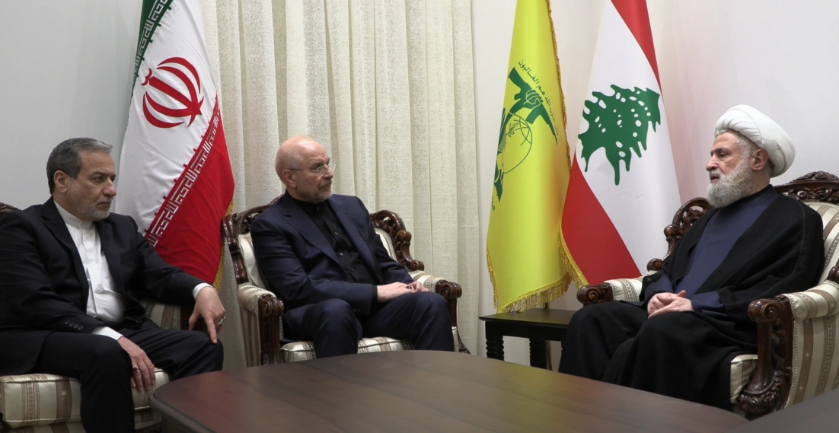
Araghchi and Ghalibaf with Naim Qassem (Al-Mayadeen, February 26, 2025)
Iranian Supreme Leader Ali Khamenei issued a communiqué on the occasion of Nasrallah’s funeral, stating that the “enemy” must know that “the resistance against the theft, oppression, and arrogance” does not end and will continue until the desired goal is achieved (Tasnim, February 23, 2025).
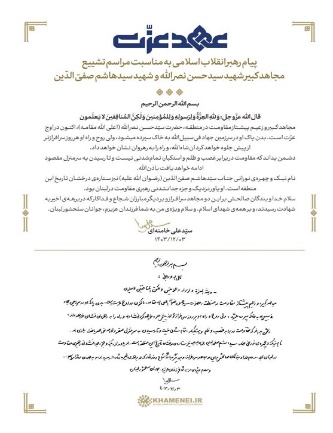
The Supreme Leader’s communiqué (Tasnim, February 23, 2025)
IRGC Commander Hossein Salami said in a speech in Tehran on the occasion of Nasrallah’s funeral that the former secretary-general of Hezbollah had forced a ceasefire on the “Zionist regime” and had broken its capabilities in the organization’s attacks. He noted that the “enemies” thought they would eliminate Hezbollah by killing its commanders and leaders, but the young Lebanese fought against the “Zionist army” in southern Lebanon and forced it to retreat (Tasnim, February 23, 2025)
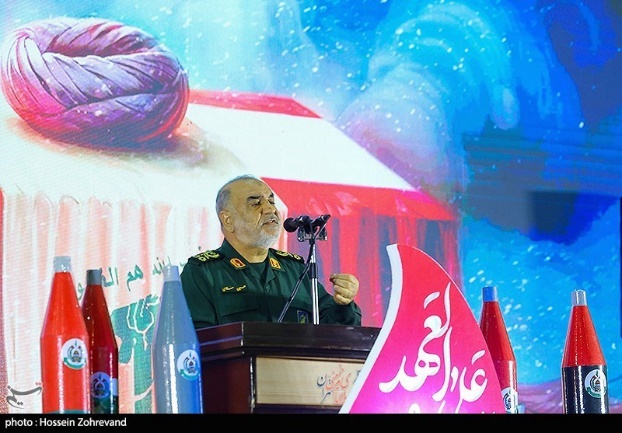
The IRGC commander (Tasnim, February 23, 2025)
Iranian Foreign Ministry Spokesman Esmail Baghaei condemned the IDF’s Air Force activity in the skies of Beirut during Nasrallah’s funeral. He said Israel reached a new low when it tried unsuccessfully to intimidate the hundreds of thousands of Lebanese and non-Lebanese participants at the funeral by flying fighter jets at low altitude. He noted this was not only a serious violation of Lebanese sovereignty but also an “act of terror” that requires condemnation from the UN and the Security Council (Esmail Baghaei’s X account, February 23, 2025). Foreign minister Abbas Araghchi also addressed the Israeli Air Force’s activity in Beirut, asserting that it constituted a violation of Lebanon’s sovereignty and an “act of terror” (Abbas Araghchi’s X account, February 23, 2025).
The Iraqi militias
Falih al-Fayyad, head of the Popular Mobilization Forces, the umbrella organization of the pro-Iranian militias in Iraq, and Abu Fadak al-Mohammadawi, head of the Popular Mobilization Headquarters, attended the funeral in Beirut (Saberin News Telegram channel, February 23, 2025). According to “Iraqi sources,” the senior officials arrived on an Iraqi Airways private plane and brought with them a sum of $4 million for Hezbollah (Sky News in Arabic, February 22, 2025).
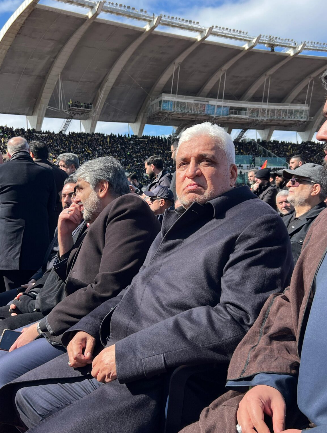
Al-Fayyad at the funeral ceremony (Popular Mobilization website, February 23, 2025)
A delegation from the Nujaba Movement, led by the head of the militia’s political council, Ali al-Assadi, participated in the funeral ceremony of Nasrallah and Safi al-Din. Al-Assadi noted that participation in the event is a message that the “axis of resistance” still constitutes a “solid incubator” (Al-Ahed, February 22, 2025). In addition, al-Assadi said the “Islamic Resistance in Iraq” had acted in accordance with Nasrallah’s position and that he had been in contact with its leaders and was up to date with the smallest details (DefaPress.ir, February 23, 2025).
Ahead of the funeral, operatives of the pro-Iranian militias in Iraq also arrived in Lebanon, including operatives of Kata’ib Hezbollah, who also held ceremonies at the site where Nasrallah was killed in the Dahiyeh in Beirut (Saberin News Telegram channel, February 21-22, 2025).
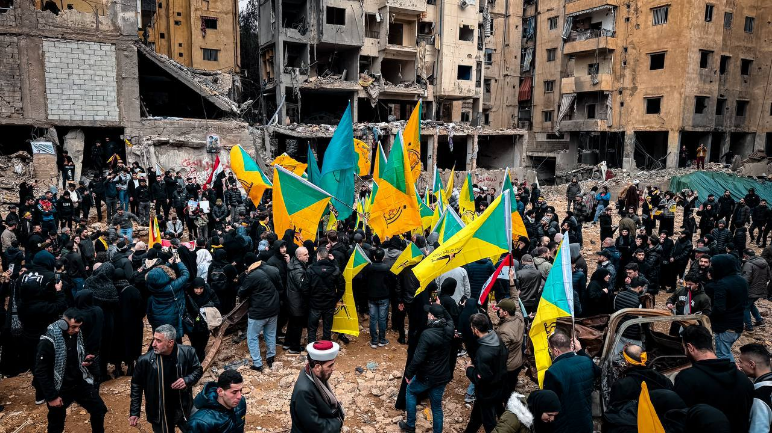
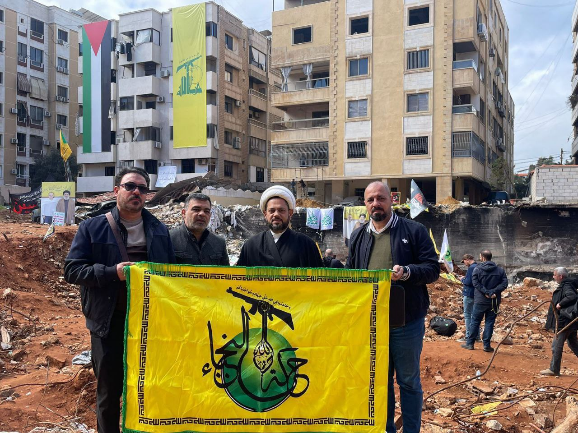
Right: Ali al-Assadi at the site where Nasrallah was killed (Nujaba Movement Telegram channel, February 24, 2025). Left: Kata’ib Hezbollah operatives at the site (Saberin News Telegram channel, February 22, 2025)
The Houthis
An official Houthi delegation led by the “Mufti of Yemen,” Shams al-Din Sharaf al-Din, with the participation of several Houthi government ministers and other senior officials, represented the Houthi movement at the funeral of Nasrallah and Safi al-Din in Beirut. Upon the delegation’s departure, Sharaf al-Din said that if not for the current circumstances, the “Leader of the Revolution” (i.e., Houthi leader Abd al-Malik al-Houthi) would have headed the delegation to Lebanon (Al-Masirah, February 21, 2025).
Mahdi al-Mashat, the head of the Houthi Supreme Political Council, stated that during his life, Nasrallah succeeded in achieving significant accomplishments such as “liberating Lebanon from the grasp of the enemy Israeli entity and shattering the myth of its invincibility.” Al-Mashat further claimed that Nasrallah’s death as a martyr embodies Islamic unity and signifies the failure of the American-Israeli project aimed at creating division among Muslims” (Al-Akhbar, February 24, 2025).
Iran in light of the developments in the Palestinian arena
Iranian President Masoud Pezeshkian, speaking at a joint press conference in Tehran with Qatari Emir Sheikh Tamim bin Hamad Al Thani, expressed his appreciation for Qatar’s mediation efforts to achieve a ceasefire in the Gaza Strip and secure the release of Palestinian prisoners. He noted that both leaders emphasized the need for coordinated action by Muslim countries to alleviate the suffering of the Palestinians in the Gaza Strip and to stop the “crimes” committed against them. He added that governments and people worldwide must make every effort to uphold the Palestinian people’s right, especially in Gaza, to live securely in their historic homeland (Tasnim, February 19, 2025).
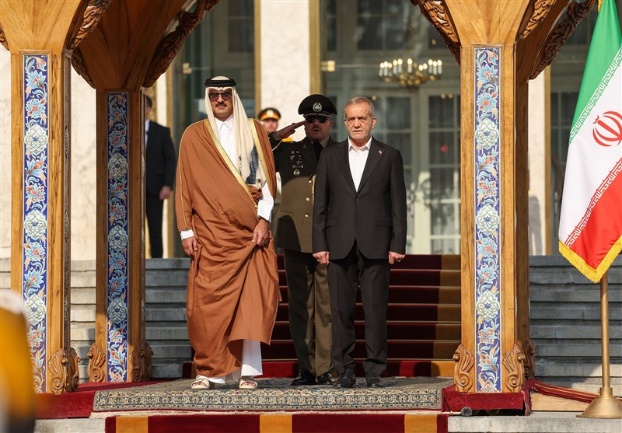
The Iranian president meets with the emir of Qatar (Tasnim, February 19, 2025)
IRGC Commander Hossein Salami met in Tehran with PIJ secretary-general Ziad al-Nakhalah. He noted that the “Al-Aqsa Flood” proved to the world how much the “Zionists” appeared strong on the outside but were very weak on the inside, and no matter how much they tried to distance themselves from their defeat and restore their image, they failed. He added that the “Zionist regime” and the United States may have had tactical victories, but in the end, they will fail. He said the Israelis clearly feel that they are defeated, while the “resistance” leaders achieved victory through their martyrdom (ISNA, February 20, 2025).
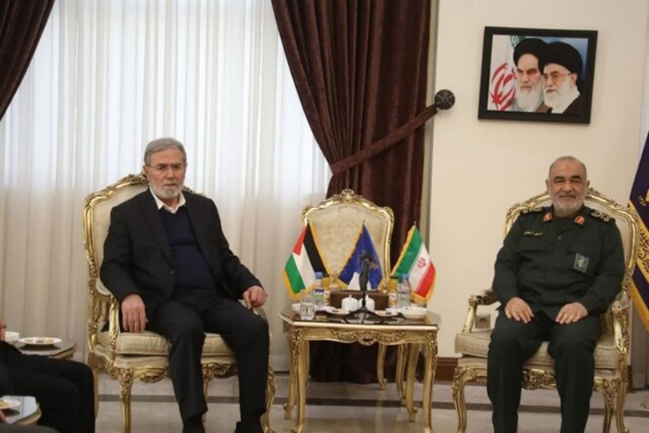
Salami meets with al-Nakhalah (ISNA, February 20, 2025)
Mohammad Bagheri, chief of staff of the Iranian armed forces, said in a meeting with al-Nakhalah that Iran had never stopped supporting Palestine and the “resistance” despite all the problems, including war, sanctions, and external pressures, and that it would continue to support it in the future. He said the courage and sacrifice of the “resistance” fighters since the beginning of the war would ensure its strength in the future as well. He added that the “Zionist regime” had not succeeded in achieving any of its goals and that the Palestinian people were the ultimate victors in the war (ISNA, February 20, 2025).
Iranian Foreign Minister Araghchi met in Geneva with UN Secretary-General António Guterres. Araghchi expressed concern about the developments in the region, especially “the continued occupation and aggression of the Zionist regime in the West Bank, as well as against Lebanon and Syria.” He called on the international community to firmly oppose the proposal to transfer the residents of the Gaza Strip and the annexation of Judea and Samaria. He also stressed the need to punish Israel for its “crimes against the Palestinians” (Iranian Foreign Ministry website, February 24, 2025).
Iran in the face of events in Syria
Ali-Akbar Ahmadian, the secretary of the Supreme National Security Council, said during a military exercise in the Kerman province that Israel is currently “occupying” defenseless Syria, but this is not a victory. He noted that a new “resistance” would emerge from Israel’s “occupation” of Syria and that “day by day we see the Syrian people liberating their country” (Tasnim, February 21, 2025).
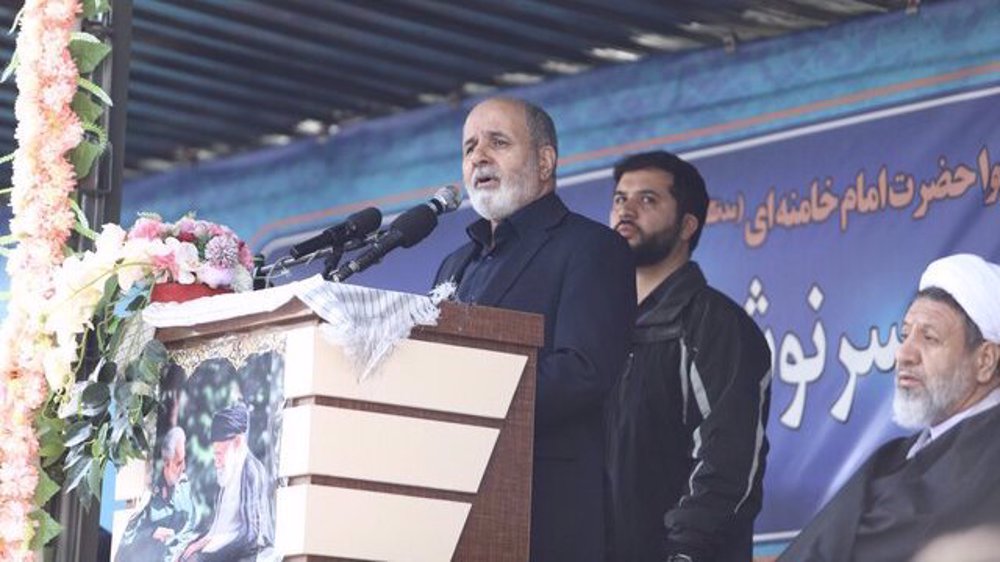
Ali-Akbar Ahmadian (Press TV, February 21, 2025)
Iranian Vice President for Strategic Affairs Mohammad Javad Zarif criticized the conduct of former Syrian President Bashar al-Assad in the period before the collapse of his regime. He said Assad had stopped significantly supporting the “resistance” and had made the mistake of pinning his hopes in the wrong places. He said that the Syrian people would not tolerate the Israeli “occupation” in Syria and would eventually stand up against Israeli “aggression” (Iranian TV, February 23, 2025).
Russian Foreign Minister Sergey Lavrov arrived in Tehran and met with his Iranian counterpart, Araghchi. The two discussed relations between the countries and developments in the region, especially in Syria. At a joint press conference with Lavrov, Araghchi said that the positions of the two countries on Syria are very close. According to him, Iran is interested in stability, peace, and the preservation of Syria’s territorial integrity and will support the establishment of peace and stability in the country (IRNA, February 25, 2025).
Iran’s involvement in Iraq
Iranian Interior Minister Eskandar Momeni visited Baghdad and met with Iraqi Prime Minister Mohammad Shia’ al-Sudani and his Iraqi counterpart, Abd al-Amir Kamel al-Shammari. During the visit, the minister discussed bilateral relations, regional issues, and cooperation between the countries in the fields of counterterrorism, drug smuggling, border security, and the movement of Iranian pilgrims to Iraq. The deputy interior minister for security affairs and the commander of the Iranian traffic police accompanied the minister on his visit (ISNA, February 22, 2025).
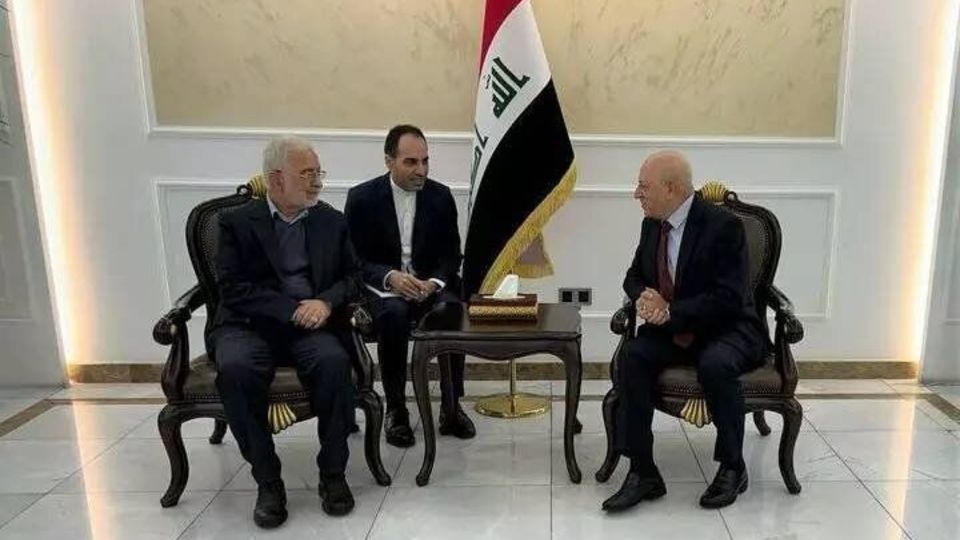
Meeting of the interior ministers of Iran and Iraq (ISNA, February 22, 2025)
The Houthis in Yemen
“Three senior US security officials” reported that Houthi forces fired several surface-to-air missiles at a US fighter jet and a US drone on February 19, 2025, as they flew over the Red Sea and over Yemeni territory not controlled by the Houthis. The “officials” said the missiles did not hit their targets, and that the United States is considering how to respond. The decision being pondered is either a targeted attack against the forces that planned the operation or damage to infrastructure and weapons storage facilities (Reuters and Fox News, February 22, 2025). It should be noted that this is the first time that a Houthi attack on a US fighter jet has been reported. Since the beginning of the war in the Gaza Strip, the Houthis claimed responsibility for shooting down 14 American MQ-9 drones over the territories under their control in Yemen.
The Houthis did not claim responsibility for the launch at the fighter jet, but “an informed military source in Sana’a” said that the interception of the planes is a “legitimate right” and part of the core missions of the armed forces that defend Yemen from external aggression. He added that the recent American statements regarding a possible attack in Yemen reflect “aggressive” intentions and that the interception of American planes in Yemeni airspace indicates the extent of the development of Yemen’s air defense capabilities (Al-Akhbar, February 25, 2025).
[1] The weekly study includes the activities of Iran, the Shiite militias in Iraq, and the Houthis in Yemen.
Related Articles
